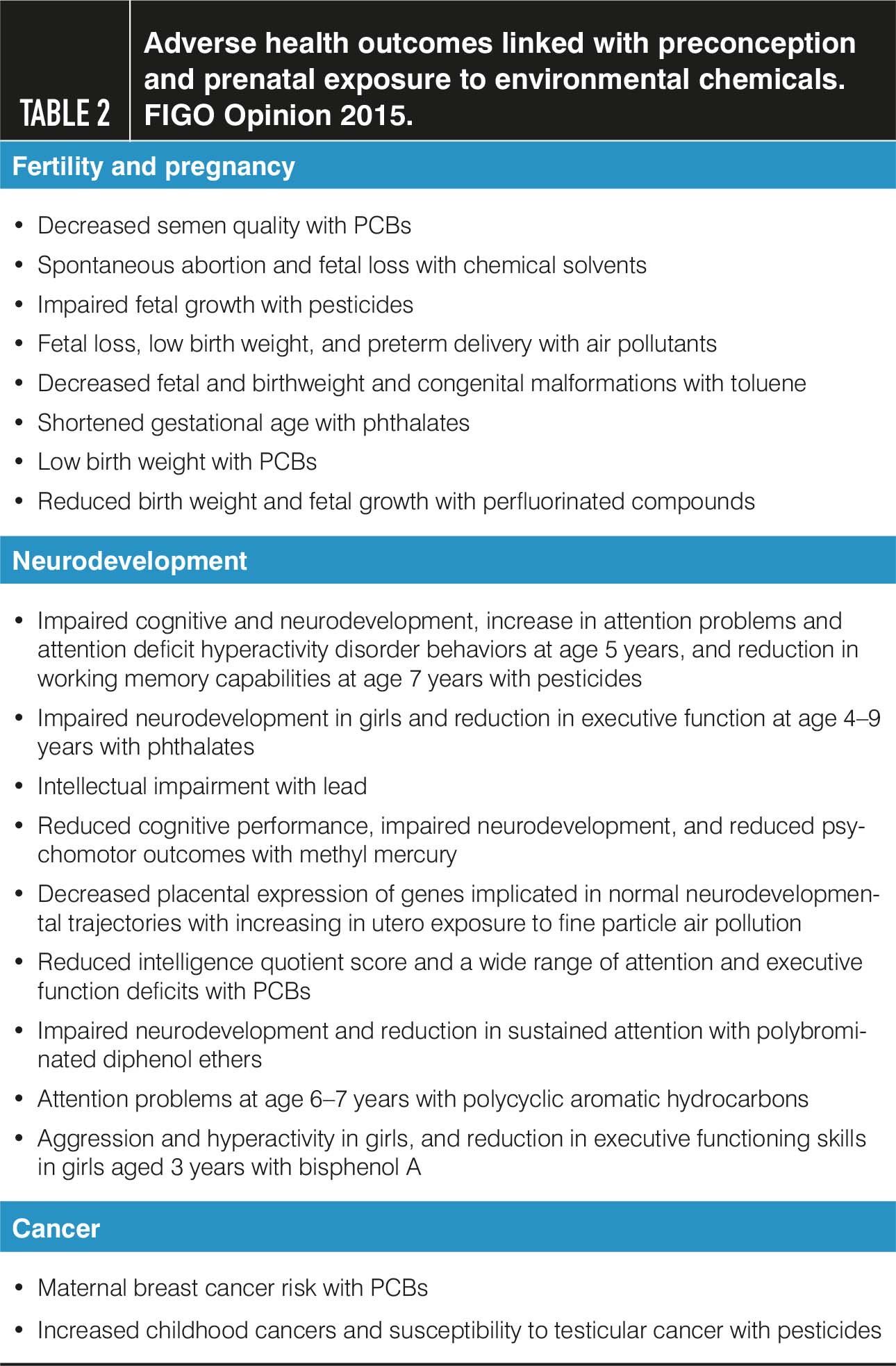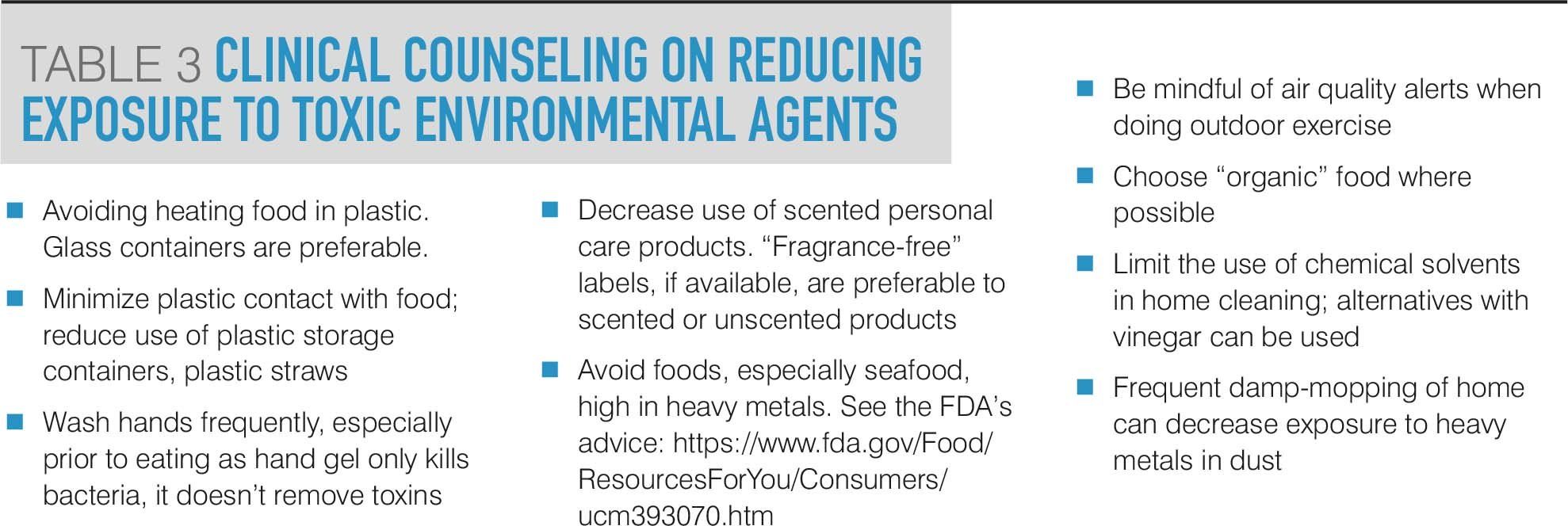Toxic environmental exposures in maternal, fetal, and reproductive health
Educating patients about toxins to avoid in daily life may seem daunting but the authors advise focusing on simple, concrete steps that women can take.
Table 1

Table 2

Table 3

Environmental health occupies a unique place in perinatal and reproductive health counseling. The “environment” can be as omnipresent as the air a woman breathes, and as specific as the cosmetic product she chooses. It can encompass the epigenetics induced by several generations of nutrition-you are what your grandmother ate-as well as the food preparation of tonight’s meal or the selection of tomorrow’s baby bottle. Given this wide range of exposures and the general inexperience with counseling patients on any of them, it is not surprising that most women’s health providers simply ignore the topic.
However, this approach is ultimately unfair to patients who need trusted sources of data to protect them from unknown toxins. Failure of such counseling misses the public health opportunity to intervene in outcomes as diverse as preterm birth (PTB), low birthweight (LBW), and neuro-developmental disorders like autism. And it fails to take advantage of resources that have emerged to provide guidance in this rapidly evolving space. Ob/gyns and all women’s health providers should become facile on environmental health risk assessment, exposure reduction, and feasible clinical counseling.
A critical window
Before delving into types of environmental exposures, it is important to consider the vital role of women’s health providers in protecting pregnancies from harm. Because pregnancy and the fetal period is perhaps the most critical time-window for human development, any toxic exposure during this time can cause lasting damage to brain development and interfere with a child’s ability to reach his or her full potential.1Further, every women’s health provider will encounter opportunities for counseling. Toxic chemicals are so numerous that every pregnant woman is likely exposed at some point in gestation to over 60 of them.2,3
To approach the intersection between environmental health and women’s health, it can be helpful to organize the exposures and outcomes. These exposures can be thought of in two general categories-toxic chemicals and climate change-related and air pollution exposures-affecting three ob/gyn health outcomes: fertility and pregnancy, neurodevelopmental impairment, and cancer.
Toxic chemicals
The United States manufactures and imports chemicals at voluminous rates. The US Environmental Protection Agency (EPA) has a chemical inventory of tens of thousands of chemicals; nearly 3,000 of these are produced or imported at > 1 million lb per year and only a scant minority are evaluated for toxic effects on brain development.4-7To focus efforts on reducing these toxic exposures, a group of expert toxicologists, health professionals, and patient advocates called Project TENDR (Targeting Environmental Neuro-Developmental Risk) developed consensus on highlighting six prime examples.1
These six toxic exposures (Table 1) include chemicals widely used in consumer products, those present in the home setting, and broad public space exposures. They are: organophosphate pesticides, polybrominated diphenyl ether (PBDE) flame retardants, combustion-related air pollutants, lead, mercury, and polychlorinated biphenyls (often used in carbonless copy paper). Each of these has been deemed contributory to neurodevelopmental disorders including learning disabilities, attention deficit hyperactivity disorder (ADHD), autism, and behavioral or intellectual impairment.1
In addition to these six examples, other groups of chemicals have been identified as chemicals of concern. Prime among them are phthalates.1Phthalates are ubiquitous in consumer products as a binding or durability agent, appearing in everything from plastic children’s toys to personal care products and perfume. Like many of the chemicals listed above, phthalates can act as endocrine disruptors, mimicking estrogen, androgen, and other hormonal effects, thereby increasing risk of not only neurodevelopmental disorders but also infertility, breast cancer, and prostate cancer.8
The American College of Obstetricians and Gynecologists (ACOG) and the International Federation of Gynecology and Obstetrics (FIGO) have issued guidance on the numerous ob/gyn health outcomes at risk due to these toxic environmental exposures as they concern fertility and pregnancy, neurodevelopmental impairment, and cancer (Table 2). In addition to outcomes discussed above, these include PTB, LBW, spontaneous miscarriage, and decreased semen quality.9,10
Air pollution and climate change
Similar to the broad expanse of environmental health, a discussion of air pollution and climate change and human health has far-reaching implications across multiple generations. The American Academy of Pediatrics (AAP) lists numerous climate-related effects on children alone, including heat stress, increased allergy and asthma exacerbation, heightened infection risk due to altered vector-borne disease patterns, psychological sequelae of weather disasters, and food and water insecurity.11The Medical Society Consortium on Climate and Health (MSCCH), a coalition of over 20 medical societies representing nearly half of US physicians, has published a “Medical Alert!” describing other climate-related health impacts like exacerbations of chronic disease, increased hospitalizations for bronchitis, chest pain, and increased risk for lung cancer.12
The health effects of air pollution and extreme heat are of particular concern for pregnant women and the developing fetus. Numerous studies have linked air pollution with PTB and LBW babies. These have been conducted on large US populations as well as with international studies.13,14Specific to the United States, an estimated 3.32% of PTB could be attributed to the air pollutant fine inhalable particulate matter < 2.5 µ (PM 2.5), creating $760 million in medical costs.13Proximity to fracking sites has also been associated with low birthweight.15Extreme temperature during the third trimester-defined as cold below the 10thpercentile or heat above the 90thpercentile of average temperatures for a region-increases the risk of LBW by 30%.16-18
Clinical counseling and patient advocacy
In the face of so many toxic environmental exposures, some of which seem ubiquitous and unavoidable, it can be daunting to approach solutions. Nonetheless, solutions are imperative. Future generations deserve protection from outcomes like PTB, LBW, and neurodevelopmental delay.
In clinical practice, the focus can be on simple, individual steps (Table 3). Avoiding heating foods in plastic containers can reduce exposure to plastic resins that have endocrine-disrupting effects. Avoiding any food that comes into substantial contact with plastic is even better. Patients can limit heavy metals with their seafood choices. Providers can take a minute to review counseling on personal care products; some brands contain hidden chemicals such as phthalates that are used to bind scents.19Because personal care products with scents contain endocrine-disruptor phthalates, “fragrance-free” versions are probably preferable. Even those that are labeled “unscented” are less desirable, as these likely contain multiple scents that are still bound by phthalates that are mixed to cancel each other out. Fast food, in addition to its nutrition concerns, typically comes in phthalate-lined wrapping that can increase exposure to endocrine disruptors.20A web-based tool from the Centers for Disease Control and Prevention’s ATSDR will be released soon. The Prenatal Assessment of Environmental Risk website will allow women and their providers to focus on individual risks based on the latest science.As stated in guidelines from ACOG, “Pregnant women should eat fish for their nutritional benefits, but take care to avoid fish that may contain high levels of mercury or other toxins.”21The FDA provides clear advice to women (at: http://bit.ly/FDAConsumerResources); this link is also available through ACOG’s Guidelines for Perinatal Care at http://bit.ly/ACOGPerinatalCare.
Also, clinicians can play a crucial role as patient advocates. This can be done by participating in awareness campaigns (FIGO hosts an annual Earth Day Social Media Campaign with health messages @FIGOHQ) or interacting directly with representatives (former ACOG President’s blogs have challenged ob/gyns to be champions of environmental science.22
And finally, recall too, that all of the gains made toward more pristine environments-clean water standards, decreased lead in gasoline and paint, reduced pollution with improved recycling campaigns-all pass on to the patient as well. Generations of work have built the foundation for healthier, sustainable improvements.
Healthy mom, healthy baby starts with a healthy environment.
References:
- Project TENDR: Targeting Environmental Neuro-Developmental Risks. The TENDR Consensus Statement. Environ Health Perspect. 2016 July 1;124(7):A118-122.
- Woodruff TJ, Zota AR, Schwartz JM. Environmental chemicals in pregnant women in the United States: NHANES 2003–2004. Environ Health Perspect. 2011 June;119(6):878–885.
- Wang A, Gerona RR, Schwartz JM, et al. A suspect screening method for characterizing multiple chemical exposures among a demographically diverse population of pregnant women in San Francisco. Environ Health Perspect. 2018 July 24;126(7):07709.
- US EPA (U.S. Environmental Protection Agency). 2006. 2006 Inventory Update Reporting: Data Summary. Available at: http://www.epa.gov/sites/production/files/documents/2006_data_summary.pdf Accessed August 15, 2018.
- US EPA. 2012. 2012 Chemical Data Reporting Results. 2018. Available at: http://www.epa.gov/chemical-data-reporting/2012-chemical-data-reporting-results Accessed August 15, 2018.
- Grandjean P, Landrigan PJ. Developmental neurotoxicity of industrial chemicals. Lancet. 2006;368(9553):2167–2178.
- Grandjean P, Landrigan PJ. Neurobehavioural effects of developmental toxicity. Lancet Neurol. 2014;13(3):330–338.
- Birnbaum:NIEHS, Sharpe and Irvine, 2004
- ACOG Committee Opinion 575: Exposure to Toxic Environmental Agents. Obstet Gynecol. 2013 Oct;122(4):931-935.
- Di Renzo GC, Conry JA, Blake J, DeFrancesco MS, DeNicola N, Martin JN Jr, et al. International Federation of Gynecology and Obstetrics opinion on reproductive health impacts of exposure to toxic environmental chemicals. Int J Gynaecol Obstet. 2015 Dec;131(3):219-225.
- Ahdoot S, Pacheco SE; COUNCIL ON ENVIRONMENTAL HEALTH. Global climate change and children’s health. Pediatrics. 2015 Nov; 136(5):31468-31484.
- Medical Society Consortium on Climate and Health. Medical Alert! Climate Change is Harming Our Health. 2016. Available at: https://medsocietiesforclimatehealth.org/wp-content/uploads/2017/03/gmu_medical_alert_updated_082417.pdf Accessed August 15, 2018.
- Trasande P, Malecha P, Attina TM. Particulate matter exposure and preterm birth: estimates of U.S. attributable burden and economic costs. Environ Health Perspec.; 2016 Dec;124(12):1913-1918.
- Malley CS, Kuylenstierna JC, Vallack HW, Henze DK, Blencowe H, Ashmore MR. Preterm birth associated with maternal fine particulate matter exposure: A global, regional and national assessment. Environ Int. 2017 Apr;101:173-182.
- Currie J, Greenstone M, Meckel K. Hydraulic fracturing and infant health: New evidence from Pennsylvania. Sci Adv. 2017 Dec 13;3(12):e1603021.
- National Institutes of Health. Extreme temperatures may increase risk for low birth weight at term, NIH study suggests. Available at: https://www.nih.gov/news-events/news-releases/extreme-temperatures-may-increase-risk-low-birth-weight-term-nih-study-suggests Accessed August 15, 2018.
- Ha S, Zhu Y, Sherman S, Mendola P. Ambient temperature and air quality in relation to small for gestational age and term low birthweight. Environ Res. 2017 May;155:394-400.
- Ha S, Liu D, Zhu Y, Kim SS, Sherman S, Mendola P. Ambient temperature and early delivery of singleton pregnancies. Environ Health Perspect. 2017;125:453-459.
- Zota AR, Shamasunder B. The environmental injustice of beauty: framing chemical exposures from beauty products as a health disparities concern. Am J Obstet Gynecol. 2017 Oct;217(4):418.e1-418.e6.
- Varshavasky JR, Morello-Frosch R, Woodruff TJ, Zota AR. Dietary sources of cumulative phthalates exposure among the U.S. general population in NHANES 2005–2014. Environ Int. 2018 Jun;115: 417-429.
- AAP Committee on Fetus and Newborn and ACOG Committee on Obstetric Practice. Guidelines for Perinatal Care, 8th Edition. 2017.
- Gellhaus T. This Earth Day be a champion for environmental science. Available at: http://acogpresident.org/?p=1453 Accessed August 15, 2018.
A Legacy of Excellence: Reflecting on the Final Print Edition of Contemporary OB/GYN
April 25th 2025Marking the end of an era and the beginning of a new chapter, the final print edition of Contemporary OB/GYN celebrates over 50 years of evidence-based guidance and unwavering support for clinicians.
Read More
